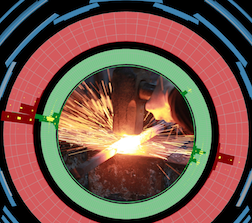The ATLAS collaboration has performed studies of a wide range of QCD phenomena, from soft particle to hard photon and jet production. Among recent results are the measurement of Z event shape observables sensitive to the modelling of the underlying event, and the measurement of diffractive dijet production with a large rapidity gap, which tests the interplay of soft and hard phenomena. The...
I will talk about the importance of boosted jets and jet substructure at the LHC. Then, I will make a comparison between techniques that discriminate two-pronged signals from QCD background using constraints on energy flow within boosted jets. To that aim, I focus on three commonly-used jet shapes: N-subjettiness, the mass-drop parameter and energy-correlation functions. I will show that we...
Our group studied the low-lying hadron spectrum of lattice QCD on a large $32^3 \times 256$
anisotropic space-time lattice at a near-physical pion mass of $240$ MeV.
Quark fields were smeared using a
Laplacian Heaviside kernel which is later exploited to estimate quark
propagation with a novel method: the Dirac matrix-inverse is stochastically
estimated by introducing noise vectors in the...
The proton radius puzzle challenges our understanding of the structure of the proton. It can be an indication of a new force that couples to muons, but not to electrons. An effective field theory analysis using Non-Relativistic Quantum Electrodynamics (NRQED) indicates that the muonic hydrogen result can in interpreted as a large, muon-proton spin-independent contact interaction. The muonic...
TeV-scale new physics addressing the hierarchy problem can leave imprints on precision observables. In the absence of new light states, effective field theories (EFT) provide a consistent framework to characterize deviations from the Standard Model that is completely general. On the other hand, the historically influential oblique parameters (most notably S, T parameters) formalism is...
The talk will summarize recent measurements of multi-boson production by the
ATLAS Collaboration.
Vector boson production in pp collisions at 7, 8 and 13 TeV has been extensively studied by ATLAS. Recent results include the precision measurements of the transverse momentum of the Z/gamma* boson production, sensitive to soft resummation effects, hard jet emissions and electroweak corrections. A precise measurement of the angular coefficients of the Zboson production tests the underlying...
